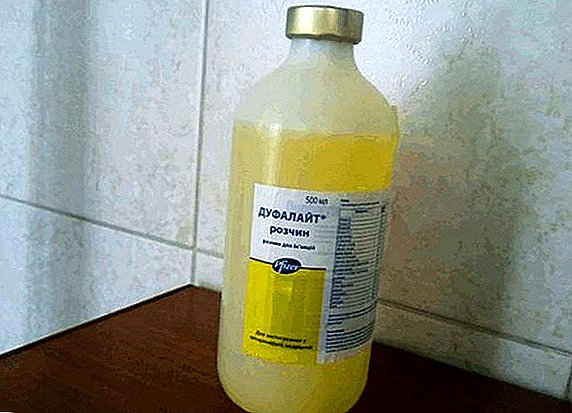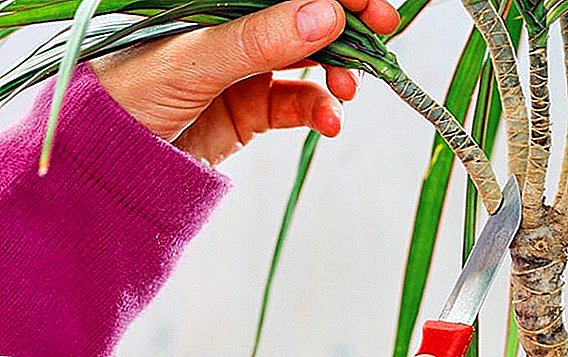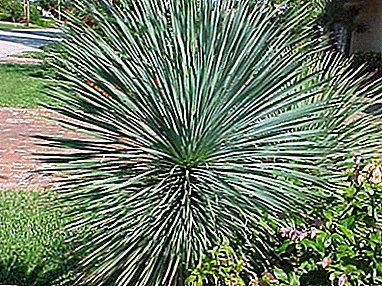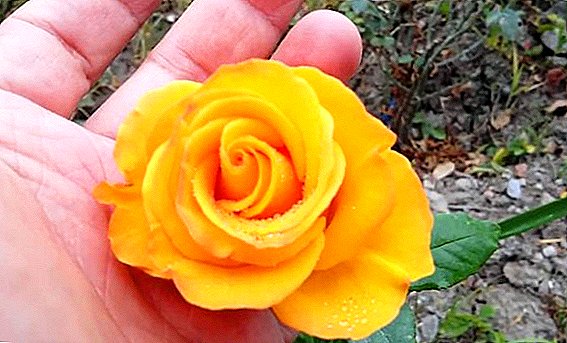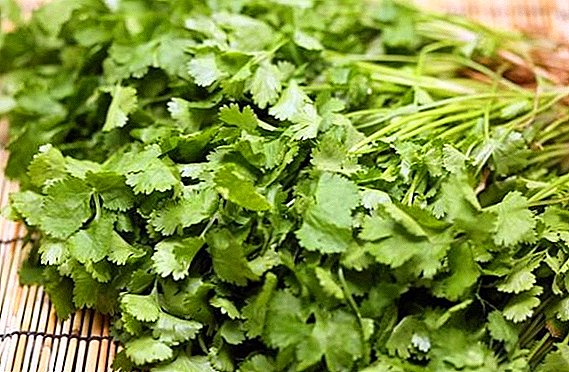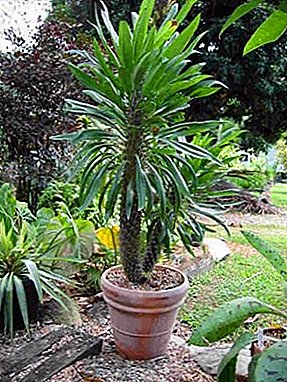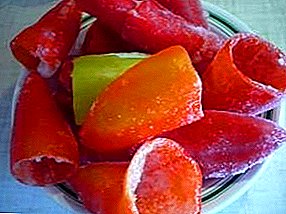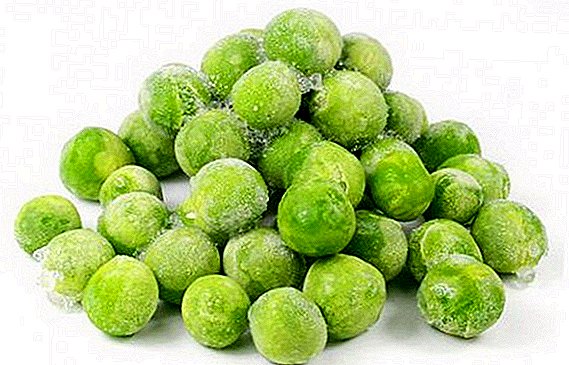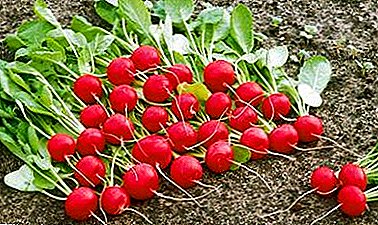
Radish Dabel is a sought-after and popular variety, featuring fast, full-fledged ripening of large homogeneous root crops. It can be grown in open and closed ground, so agronomists are engaged in the cultivation of radish of this variety from early spring to late autumn.
The root crop is distinguished not only by its excellent external characteristics, but also by its amazing taste. In rare cases, there are voids inside, but only through the agronomist’s own fault. The rest - radish Dabel - is a great vegetable that will not only decorate your table, but also make the meal useful and enjoyable!
Characteristic and description
Appearance
 Large-fruited early ripe hybrid grade of a radish. Root Vegetable:
Large-fruited early ripe hybrid grade of a radish. Root Vegetable:
- dense;
- smooth;
- smooth;
- in diameter up to 4 - 4.5 cm;
- round shape;
- pronounced red hue;
- fetal head slightly flattened;
- white flesh juicy, gently - spicy to the taste;
- average root weight - up to 35 g;
- leaves oblong, dense, narrow, green colors;
- the tops are small, which makes it easy to pack into small bundles at harvest.
Sowing time
In film shelters in protected ground, radishes can be planted all year round.
Attention! The best time for planting in closed ground is late autumn - early March. In the open ground, seeds of the Dabel F1 variety are sown in April, when the frosts will pass, the first heat will be established.
Productivity from 1 ha
The variety has a high yield. From 1 square. m. on average, they collect up to 6 - 7.5 kg of root crops (from 1 ha to 60 tons).
Where is it recommended to grow?
Radish Dabel F1 is recommended to be planted immediately in open ground. Early sowing is carried out in closed ground under a film cover. In greenhouses can be grown even in winter.
Disease resistance
Radish Dabel F1 is resistant to tsvetushnosti.
In open ground should be sown only with the onset of constant heat, low air temperature retards the development of root crops, provokes marksmanship.
Ripening
The variety has an average root aging rate. An average of 3-4 weeks passes from sowing seeds to harvesting., depending on the region and conditions of detention.
What kind of soil does it prefer?
 It prefers light, friable, neutral in acidity soils.
It prefers light, friable, neutral in acidity soils.
The soil for sowing is prepared in advance in the fall.
The composition of fertilizers for soil fertility (per 1 sq. m.):
- humus - 4 - 5 kg;
- superphosphate - 50 g;
- potassium sulfate - 30 - 40 g
In the spring the plot is dug up, loosening is necessary. Nitrogen supplements are introduced - 30-40 g of ammonium nitrate per 1 sq. M. m
Breeding history
The hybrid variety Dabel F1 belongs to the genus Radish of the Cabbage family.
Radish was brought to Russia by Peter I from Amsterdam. Bred in 2006 in Holland, radish Dabel F1 is grown in many countries, adapted to any climatic conditions.
Difference from other varieties
Dabel F1 is one of the fastest growing radish varieties. With proper care, the roots ripen in 2.5 - 3 weeks, ahead of other varieties by the term of ripening for 5 - 7 days. The variety is cold-resistant, resistant to viral infections. Differs in the large sizes of root crops which due to genetic features ripen at the same time.
Advantages and disadvantages
The pulp of the root includes fiber, many vitamins of group B1, B2, C. The pulp contains:
- potassium;
- phosphorus;
- iron;
- salicylic acid.
Early vegetable restores immunity after winter, has anti-edematous properties. Pulp juice:
- stimulates the secretion of gastric juice;
- improves digestion;
- increases appetite.
It is recommended to eat when:
- obesity;
- gout;
- diabetes.
Important! The pulp contains mustard oil, irritating the stomach.
Contraindications:
- People suffering from chronic diseases of the stomach should be eaten with caution.
- Children should be introduced into the diet gradually, from 3 - 4 years.
- Also, do not eat root vegetables for those who suffer from inflammation of the gallbladder, pancreas.
- For ulcers and gastritis it is necessary to limit the use.
What and where is it used for?
 Basically radish Dabel F1 is used for:
Basically radish Dabel F1 is used for:
- salads;
- okroshka;
- cold snacks.
The leaves are also edible, they are added to salads in a ground form.
Not everyone knows that in fact there are many more minerals and vitamins in the leaves than in the root crops themselves. However, this does not mean that now you definitely need to eat leaves. If their taste is not to their liking, then you should not torture yourself.
Such "vitamin supplements" improve metabolism, reduce cholesterol.are atherosclerosis prevention.
Growing up
A field for sowing in open ground should be well lit.
Attention! Seeds are better to use ready, pickled with special preparations. Immediately before planting, the seeds should be wrapped in a damp napkin, put in a warm place for a day.
Sow the seeds belt method:
- in each tape 5 to 8 rows;
- the distance between the rows in the tape is 15-20 cm;
- the distance between the tapes is 60 cm.
Dabel F1 radish sowing scheme:
- Seeds are deepened by 2 - 2.5 cm.
- To speed up the germination of seeds, sowing is covered with a film or agrofibre.
- Watering moderate.
- Permissible air temperature at landing is 4 - 5 ° С.
- The optimum temperature for the growth of seedlings is 13 - 14 ° C.
- With the appearance of the first leaflets, sprouts must be thinned.
In a closed planting, crops can be sealed to 4 - 5 cm (scheme - 6 to 5 cm). For growth intensity requires fertilizing. It is better to use mineral fertilizers:
- "Potassium concentrate growth";
- Plantafol;
- "Megafol".
Weeding and occasional loosening of the soil is mandatory.
Harvesting and Storage
 After 20 - 25 days after sowing, you can harvest. Harvest radish Dabel F1 harvested immediately, in one pass.
After 20 - 25 days after sowing, you can harvest. Harvest radish Dabel F1 harvested immediately, in one pass.
Root vegetables are pulled out easily. It is better to cut the tops under the root. To keep the roots in the soil should not be.
You can store bundles, well kept without tops. In a warm room can not save, the roots quickly become sluggish and flabby. It is better to store in the cellar or in the lower sections of the refrigerator.
In bundles, root crops are preserved for 3–4 days, in purified form - 7–10 days.
Diseases and pests
- Mucous bacteriosis and downy mildew affect crops of Dabel F1 radish when overmoistening the soil, thick planting. The soil and leaves should be treated with fitoherm.
- Bacteriosis is transmitted through seeds. Before sowing, heat treatment of seeds is required.
- From a gray rot will help get rid of a solution aktofita.
- A mixture of wood ash, lime, tobacco dust (1: 1: 1) is used for the prevention and control of cruciferous flowers.
- Aphids, carrot flies, cabbage leaves are destroyed by treating the soil and leaves with any insecticides (lipocide, condor, etc.).
Prevention of various problems
- For the prevention of the appearance of pests and infections that they spread, one should arrange the sowing at the very initial stage of cultivation.
- In order for root crops to develop evenly, not to crack, it is necessary to strictly observe the regimen and dosage of dressings, avoid overflows - the soil should be moderately wet.
- To prevent strelkovo, sowing in open ground is carried out only in warm weather.Reference. Prolonged cold retards growth and development of root crops.
Similar varieties
Lightning
Hybrid early ripe grade. Leaves obovate, medium in size, green with a grayish tinge. The root weight is 35-40g. The color of the root is deep red. The flesh is white, glassy, juicy, with a slight bitterness to taste. It can be grown up in the greenhouse and in an open ground. Productivity is high, up to 3.5 - 4 kg per 1 square. m
Anabel
The tops are small, the leaves are grayish-green. Root crops are round, small (weighing up to 25 g), bright red. The peel is thin, smooth. The flesh is white, dense. The variety is disease resistant. Yields up to 3 kg per square meter. m
Celeste
Early hybrid variety. Root crops are round, shiny, bright red color. The diameter of the root - up to 3 cm, diameter - 3 cm. The pulp is dense in structure, slightly acute in taste. The variety is grown indoors and outdoors. Productivity is high, up to 3.5 kg per 1 sq. M. m
Rondar
Also applies to early maturing varieties. Root crops are round, of a rich red color, with a diameter of up to 3 cm. The variety is resistant to tsvetushnosti, yields are high, up to 3.5 kg per square meter. m. The flesh is juicy, slightly acute in taste, white. The root crop retains its elasticity for a long time.
Radish Dabel F1 - an ideal grade for an early harvest. The grade is unpretentious, does not require special attention and time-consuming care.


